Andersen Corporation Bundle
How did Andersen Corporation become a window and door giant?
Founded in 1903, Andersen Corporation's story is a testament to enduring innovation in the window manufacturing industry. Starting in Hudson, Wisconsin, this Minnesota company quickly established itself as a key player, initially focusing on lumber before pivoting to high-quality window frames. This strategic shift was critical to meeting the growing demand for reliable building materials in the early 20th century, setting the stage for its future success.
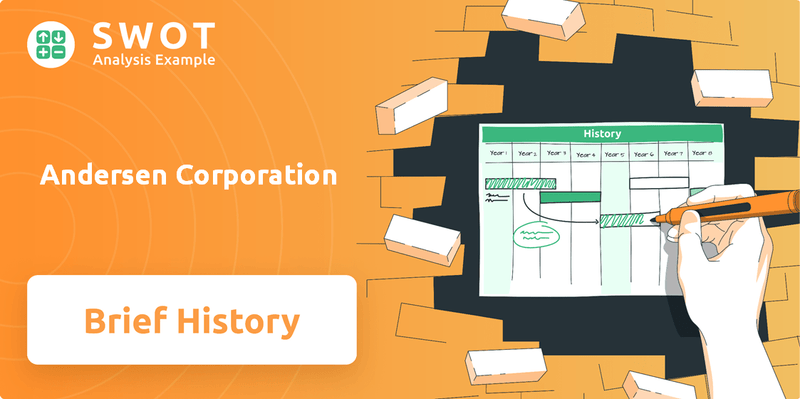
From its early days, Andersen Windows has consistently adapted and expanded its product offerings. Today, the company boasts a significant market share, providing solutions for both residential and commercial projects. To further understand their strategic approach, consider a detailed Andersen Corporation SWOT Analysis, which highlights key factors in their continued success and product evolution.
What is the Andersen Corporation Founding Story?
The story of Andersen Corporation, a cornerstone in the window manufacturing industry, began on July 10, 1903. Founded by Hans Andersen and his family in Hudson, Wisconsin, the company's inception was rooted in the entrepreneurial spirit of a Danish immigrant.
Hans Andersen's vision was to address the growing need for standardized, high-quality building components in a rapidly changing America. This led to the development of pre-fabricated window frames, a pioneering concept at the time. The company's evolution reflects a commitment to innovation and a deep understanding of the construction market.
The initial focus was on producing and selling lumber, but it quickly shifted to include pre-fabricated window frames. The first product was the '2-light' window frame, designed for easy assembly and installation. The company's name, simply the family name, underscored a commitment to quality and integrity.
Andersen Corporation's early success was significantly influenced by the rapid urbanization and residential construction boom of the early 20th century.
- The initial funding came from bootstrapping and family resources.
- A key challenge was convincing builders to adopt pre-fabricated components over custom-built methods.
- The company's early innovation, the '2-light' window frame, streamlined construction.
- The company's headquarters is located in Bayport, Minnesota.
The company's early challenges included convincing builders to adopt pre-fabricated components over traditional methods. The company addressed this by demonstrating the efficiency and cost-effectiveness of their products. The cultural and economic context of the early 20th century, marked by rapid urbanization and a surge in residential construction, significantly influenced the company's creation and early success.
In recent years, the company has shown commitment to sustainability. As of 2024, Andersen has set goals to reduce its carbon footprint, reflecting a commitment to environmental responsibility. The company's focus on innovation and sustainability continues to shape its future, ensuring its place in the window manufacturing industry.
Andersen Corporation SWOT Analysis
- Complete SWOT Breakdown
- Fully Customizable
- Editable in Excel & Word
- Professional Formatting
- Investor-Ready Format
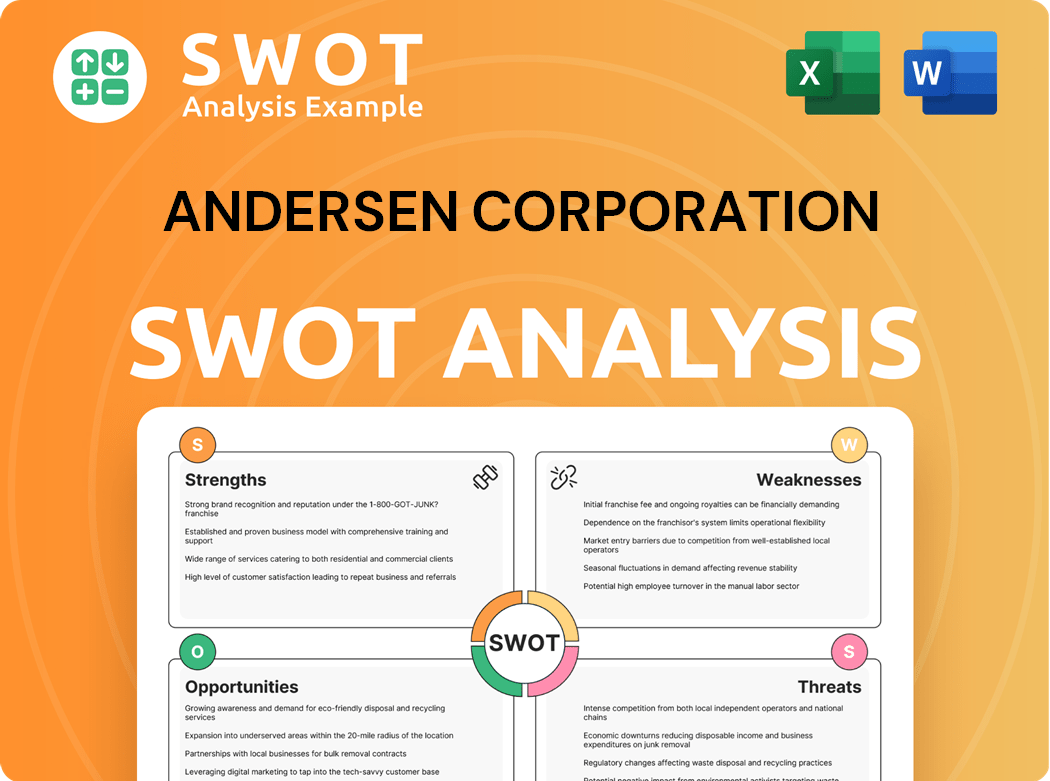
What Drove the Early Growth of Andersen Corporation?
The early growth of Andersen Corporation, initially focused on lumber, pivoted towards specialized window manufacturing. This transition included significant innovations and strategic market entries. Key to this phase was the introduction of the first fully assembled window unit, which revolutionized construction practices.
A pivotal moment in the company's early history was the development of the first completely assembled window unit in 1905. This innovation significantly simplified installation and construction processes, setting a new standard in the building materials industry. This innovation was crucial for the company's early success and market differentiation within the Andersen Windows history.
Early sales strategies targeted the growing residential markets, particularly in the Midwest. This geographic focus allowed the company to establish a strong presence and brand recognition. By focusing on these markets, Andersen Corporation was able to achieve significant sales milestones in its initial years.
The expansion of the team focused on skilled carpenters and assembly workers to meet the increasing demand for their products. The establishment of the first dedicated manufacturing facility in Bayport, Minnesota, in 1913, was a crucial step. This facility remains a primary operational hub, reflecting the company's commitment to its roots.
The company expanded its distribution network beyond local lumberyards, reaching dealers across the Midwest and eventually nationwide. This wider distribution strategy enabled Andersen Windows to increase its market reach and accessibility. This expansion was key to the company's growth and national presence.
Andersen Corporation PESTLE Analysis
- Covers All 6 PESTLE Categories
- No Research Needed – Save Hours of Work
- Built by Experts, Trusted by Consultants
- Instant Download, Ready to Use
- 100% Editable, Fully Customizable
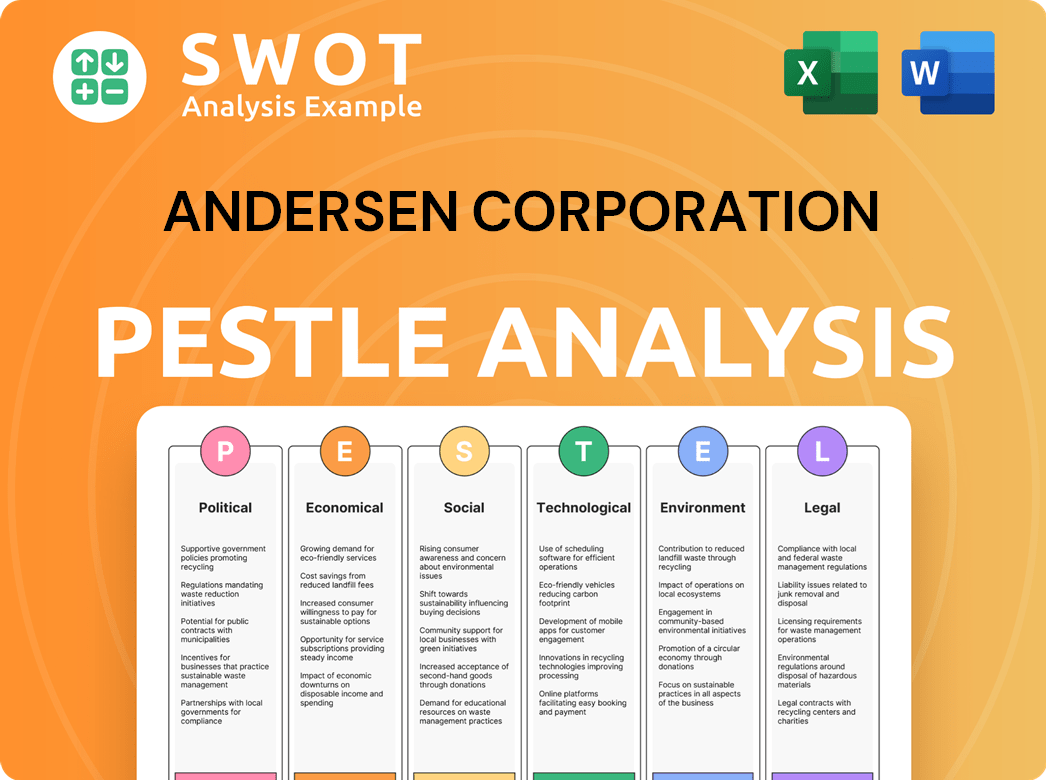
What are the key Milestones in Andersen Corporation history?
The history of Andersen Corporation, a prominent Minnesota Company, is marked by significant milestones that have shaped the window manufacturing industry. From its early days, the company has consistently introduced innovative products and strategies, establishing itself as a leader in the building materials sector. These achievements reflect a commitment to quality and a forward-thinking approach to the evolving needs of the construction market.
| Year | Milestone |
|---|---|
| 1903 | The company was founded by Hans Andersen and his family in Hudson, Wisconsin, initially as a lumber company. |
| 1960 | Introduction of the Perma-Shield system, a low-maintenance vinyl cladding for wood windows, revolutionized the industry. |
| 2000s | Expanded product lines to include a wider array of materials like fiberglass and composite, enhancing its market reach. |
| 2024 | Received recognition as an ENERGY STAR Partner of the Year, highlighting its dedication to energy efficiency. |
Andersen Windows has consistently focused on innovation throughout its history. The company has secured numerous patents, reflecting its leadership in material science and design. This commitment to innovation has allowed Andersen Windows to stay ahead of market trends and consumer preferences, reinforcing its position in the market.
This technology, introduced in 1960, provided a durable, low-maintenance solution that significantly reduced the need for painting and maintenance, setting a new standard in the industry.
Expanding beyond traditional wood, the company incorporated materials like fiberglass and Fibrex, offering consumers more choices and enhancing product performance and durability.
Andersen Windows has invested in integrating smart home technology into its products, providing consumers with enhanced convenience and control over their windows and doors.
The company has consistently focused on developing energy-efficient products, earning recognition such as the ENERGY STAR Partner of the Year award multiple times, most recently in 2024.
Andersen Windows has continually upgraded its manufacturing processes, including investing over $100 million in capital improvements across its facilities in 2023 to enhance production capabilities and product innovation.
Andersen Corporation is committed to sustainable practices, from using recycled materials to reducing waste in its manufacturing processes, aligning with growing consumer and industry demands for eco-friendly products.
Despite its successes, Andersen Corporation has faced various challenges. Market downturns, such as the 2008 housing crisis, significantly impacted the construction industry and the demand for building materials. The company has also navigated competitive pressures from new entrants and evolving consumer preferences. To learn more about the company's values, check out the mission, vision, and core values of Andersen Corporation.
The 2008 housing crisis and other economic downturns have presented significant challenges, impacting demand and requiring strategic adjustments to maintain market share.
Competition from both established and new companies in the window manufacturing industry has pushed Andersen Windows to continuously innovate and improve its products and services.
Changes in consumer tastes, including a shift towards different materials and designs, have required Andersen Windows to adapt its product offerings to meet these evolving demands.
Global events and economic factors have led to supply chain disruptions, impacting the availability of raw materials and components, necessitating agile management strategies.
Increasing demands for sustainable products and practices have required the company to invest in eco-friendly materials and processes, aligning with industry trends and consumer expectations.
Keeping pace with technological advancements, such as smart home integration and advanced manufacturing techniques, has been a constant challenge, demanding ongoing investments in research and development.
Andersen Corporation Business Model Canvas
- Complete 9-Block Business Model Canvas
- Effortlessly Communicate Your Business Strategy
- Investor-Ready BMC Format
- 100% Editable and Customizable
- Clear and Structured Layout
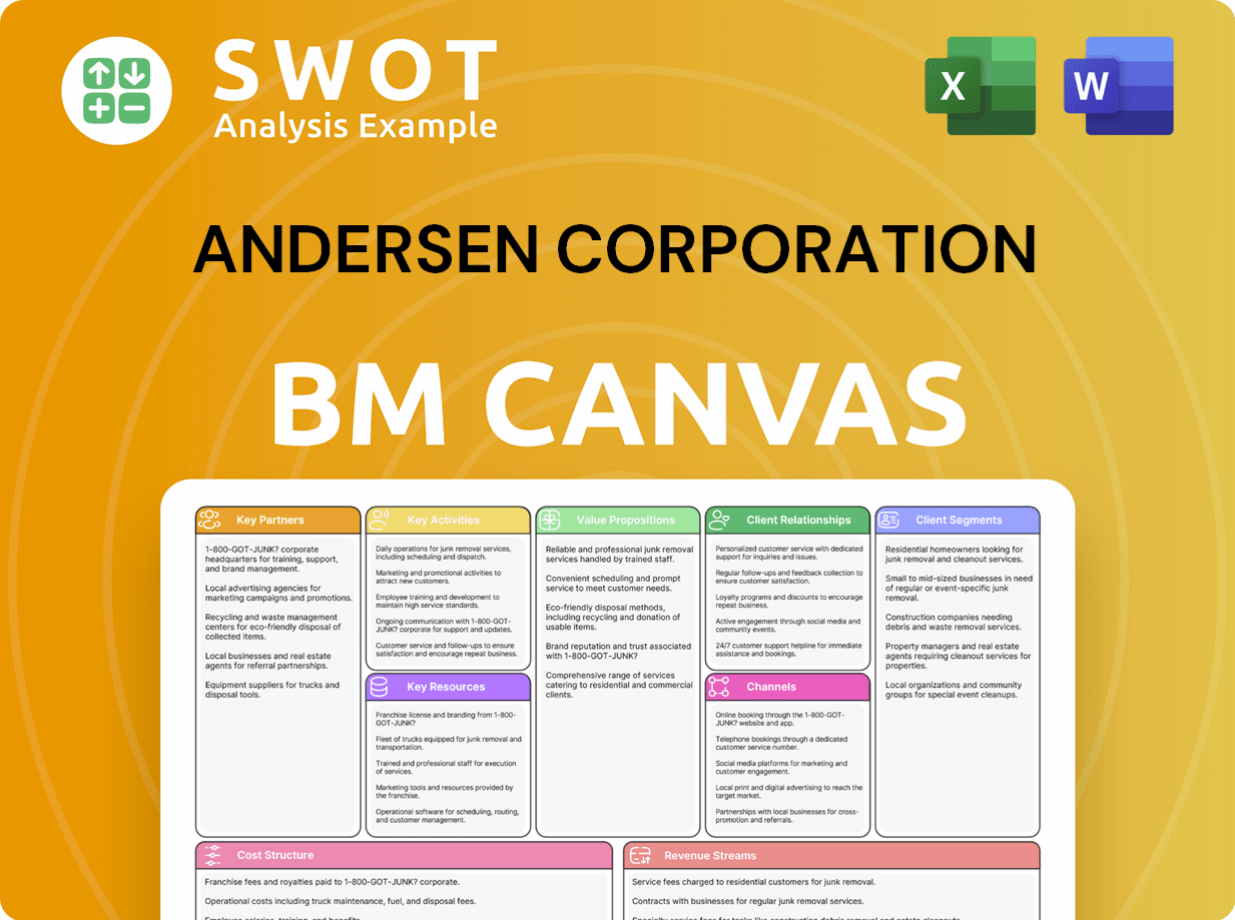
What is the Timeline of Key Events for Andersen Corporation?
The story of Andersen Corporation is a long one, marked by innovation and adaptation. Founded in Hudson, Wisconsin, in 1903, the company quickly made its mark with its first completely assembled window unit in 1905. A dedicated manufacturing facility was established in Bayport, Minnesota, in 1913. Surviving the Great Depression, the company introduced the groundbreaking Perma-Shield system in 1960, expanded internationally in the 1980s, and launched Renewal by Andersen in 1995. The company has also shown resilience, navigating the 2008 financial crisis and housing market downturn. In 2015, the acquisition of Fibrex enhanced product durability, and in 2020, the company accelerated its digital transformation. In 2024, it was recognized as an ENERGY STAR Partner of the Year, and it continues to focus on sustainable manufacturing and smart home integration.
| Year | Key Event |
|---|---|
| 1903 | Andersen Corporation founded in Hudson, Wisconsin. |
| 1905 | Introduction of the first completely assembled window unit. |
| 1913 | First dedicated manufacturing facility established in Bayport, Minnesota. |
| 1930s | Company weathers the Great Depression, focusing on essential housing needs. |
| 1960 | Introduction of the revolutionary Perma-Shield system. |
| 1980s | Expansion into international markets. |
| 1995 | Launch of the Renewal by Andersen replacement window service. |
| 2008 | Navigates the global financial crisis and housing market downturn. |
| 2015 | Acquires Fibrex, a composite material technology, enhancing product durability. |
| 2020 | Accelerates digital transformation and e-commerce capabilities. |
| 2024 | Recognized as an ENERGY STAR Partner of the Year. |
| 2025 | Continues to invest in sustainable manufacturing and smart home integration. |
Looking ahead,
The demand for energy-efficient and smart home-enabled building solutions is increasing. Sustainable and resilient construction practices are also gaining importance. The windows and doors market is projected to grow at a CAGR of approximately 4.5% from 2023 to 2028. This growth is driven by new construction and renovation activities.
Leadership emphasizes a commitment to innovation, customer satisfaction, and environmental stewardship. The company's future direction remains strongly tied to its founding vision. The goal is to provide high-quality, innovative, and reliable building solutions.
The company is dedicated to sustainable manufacturing practices. This includes the use of innovative materials and technologies. Smart home integration is a key focus for future product development. Continued investment in these areas will define the future of
Andersen Corporation Porter's Five Forces Analysis
- Covers All 5 Competitive Forces in Detail
- Structured for Consultants, Students, and Founders
- 100% Editable in Microsoft Word & Excel
- Instant Digital Download – Use Immediately
- Compatible with Mac & PC – Fully Unlocked
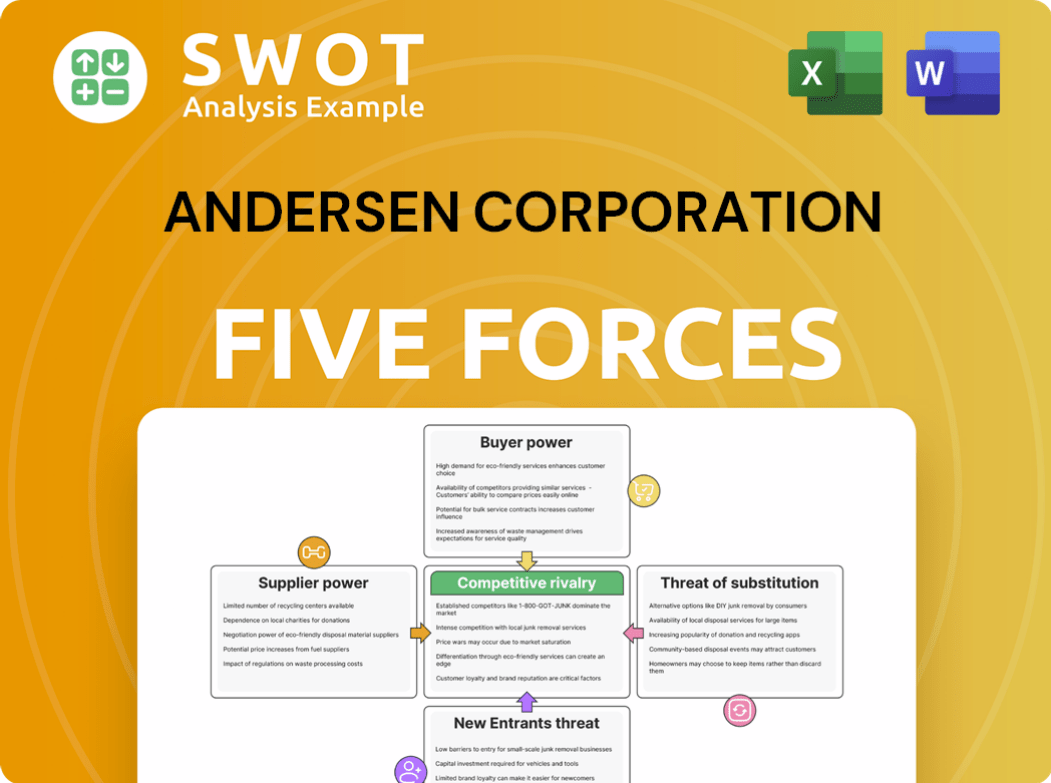
Related Blogs
- What is Competitive Landscape of Andersen Corporation Company?
- What is Growth Strategy and Future Prospects of Andersen Corporation Company?
- How Does Andersen Corporation Company Work?
- What is Sales and Marketing Strategy of Andersen Corporation Company?
- What is Brief History of Andersen Corporation Company?
- Who Owns Andersen Corporation Company?
- What is Customer Demographics and Target Market of Andersen Corporation Company?
Disclaimer
All information, articles, and product details provided on this website are for general informational and educational purposes only. We do not claim any ownership over, nor do we intend to infringe upon, any trademarks, copyrights, logos, brand names, or other intellectual property mentioned or depicted on this site. Such intellectual property remains the property of its respective owners, and any references here are made solely for identification or informational purposes, without implying any affiliation, endorsement, or partnership.
We make no representations or warranties, express or implied, regarding the accuracy, completeness, or suitability of any content or products presented. Nothing on this website should be construed as legal, tax, investment, financial, medical, or other professional advice. In addition, no part of this site—including articles or product references—constitutes a solicitation, recommendation, endorsement, advertisement, or offer to buy or sell any securities, franchises, or other financial instruments, particularly in jurisdictions where such activity would be unlawful.
All content is of a general nature and may not address the specific circumstances of any individual or entity. It is not a substitute for professional advice or services. Any actions you take based on the information provided here are strictly at your own risk. You accept full responsibility for any decisions or outcomes arising from your use of this website and agree to release us from any liability in connection with your use of, or reliance upon, the content or products found herein.